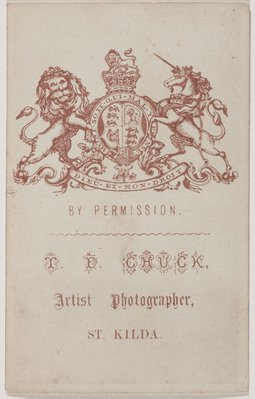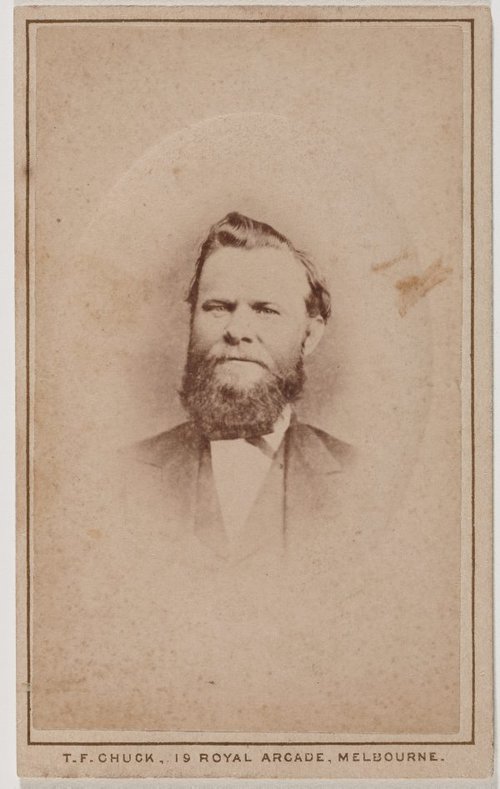-
Details
- Date
- 1868
- Media category
- Photograph
- Materials used
- carte de visite
- Dimensions
- 5.9 x 9.7 cm image; 6.3 x 10.4 cm mount card
- Signature & date
Not signed. Not dated.
- Credit
- Purchased 2014
- Location
- Not on display
- Accession number
- 287.2014
- Copyright
- Artist information
-
Thomas Foster Chuck
Works in the collection
- Share
-
-
About
Thomas Foster Chuck was an entrepreneurial itinerant photographer of portraits and views. Born in London, he arrived in Melbourne in 1852 and initially worked as a cabinet maker. In 1860 he became involved in the production and exhibition of a ‘Grand moving diorama of the Victorian Exploring Expedition’, a painted panorama wound around two rollers that recounted Burke and Wills’ fateful journey. By 1866 he had established a photographic studio called The London Portrait Gallery in Daylesford, where he photographed people and views. Travelling around the Western District, he took promotional photographic views of the Hampden and Mortlake shires which were exhibited at the Intercolonial Exhibition, where he also showed photographs of clouds after a heavy storm. In 1868 Chuck returned to Melbourne, establishing himself as ‘artist and photographer’ in the newly-built Royal Arcade. For three years from 1870 he collected photographs of early settlers for his magnum opus – a mosaic of 700 tiny portraits of explorers and early colonists of Victoria composed into a shield-like shape. In 1876 Chuck sold his business to Nicholas Caire and travelled to England. On his return to Melbourne he reportedly gave up photography and become an agent for the Evangelisation Society of Australasia.
A carte de visite is a stiff card of about 10 x 6.4 cm, with an attached paper photograph, invented in 1854 by André-Adolphe-Eugène Disderi. They were introduced into Australia in 1859 by William Blackwood with albums arriving in 1860, aiding the collection and distribution of multiple cartes. Cartes were usually portraits and were made by the millions worldwide. Multi-lens, or ‘multiplying’ cameras were introduced in the 1860s, which were capable of producing from 2 to 32 images in quick succession, dramatically increasing the number of cartes de visite that could be made from a single photographic plate. They were easily reproduced by making paper contact prints from the glass plates, which were then cut and pasted to card.
-
Exhibition history
Shown in 1 exhibition
The photograph and Australia, Art Gallery of New South Wales, Sydney, 21 Mar 2015–08 Jun 2015
The photograph and Australia, Queensland Art Gallery, South Brisbane, 04 Jul 2015–11 Oct 2015
-
Bibliography
Referenced in 1 publication
-
Judy Annear, The photograph and Australia, Sydney, Jun 2015, 250 (colour illus.).
-





